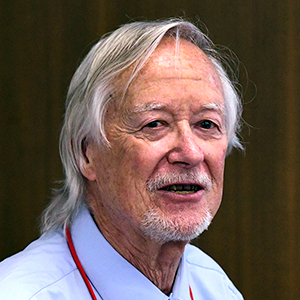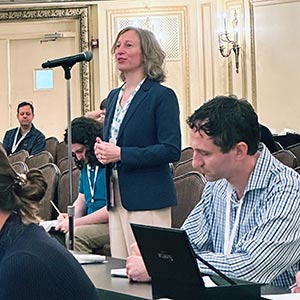New findings from NIEHS researchers could point to novel strategies for preventing or treating cancer and neurodegenerative diseases. The study, published May 8 in PLoS Biology, showed that shared mutational signatures are associated with both aging and redox stress, which is the term for a condition marked by inadequate defenses against oxidants.
Unexpected findings
 As head of the NIEHS Mutagenesis and DNA Repair Regulation Group, Doetsch investigates cellular responses to DNA damage. (Photo courtesy of Steve McCaw)
As head of the NIEHS Mutagenesis and DNA Repair Regulation Group, Doetsch investigates cellular responses to DNA damage. (Photo courtesy of Steve McCaw)“Our findings conceptually change the understanding of two fundamental biological processes — mutagenesis and aging,” said co-senior author and NIEHS Deputy Scientific Director Paul Doetsch, Ph.D. “In contrast to current dogma, we found that these mutational signatures are centered around the DNA base C [cytosine], not G [guanine].”
Redox stress, also known as oxidative stress, occurs when antioxidant defenses in cells are insufficient to neutralize potentially harmful molecules called reactive oxygen species (ROS). These unstable, oxygen-containing molecules are byproducts of metabolic reactions in the mitochondria. A buildup of ROS can damage DNA, RNA, and proteins, and may even cause cell death.
Excessive ROS may be generated in response to chronic viral or bacterial infections, or after exposure to toxic chemicals, such as certain air pollutants. Oxidative stress is a hallmark of cancer and has been proposed to play a central role in aging and age-related conditions such as Parkinson’s disease and Alzheimer’s disease, but the idea is controversial (see sidebar).
“Understanding the contribution of redox stress to the mutational signatures of cancers and aging is very important because it allows informed therapeutic decisions and dietary choices for cancer patients and for healthy people,” said Dmitry Gordenin, Ph.D., head of the NIEHS Mechanism of Genome Dynamics Group and co-senior author of the paper.
 Gordenin studies the metabolic causes of cancer and holds a secondary appointment in the NIEHS Biostatistics and Computational Biology Branch. (Photo courtesy of Steve McCaw)
Gordenin studies the metabolic causes of cancer and holds a secondary appointment in the NIEHS Biostatistics and Computational Biology Branch. (Photo courtesy of Steve McCaw)Surprising substitutions
In the new study, Doetsch’s and Gordenin’s groups characterized the mutational signatures of redox stress, focusing on genomic regions with clustered mutations in single-strand DNA. To do so, they exposed baker’s yeast to two DNA-damaging agents, hydrogen peroxide and a herbicide called paraquat, and then identified characteristic mutation signatures and searched for these signatures in 505 whole genome-sequenced human cancers. They also examined the signature of aging in mitochondrial DNA from the human brain.
Remarkably, all of these signatures were characterized by cytosine-to-thymine (C-to-T) base substitutions. “In contrast to current dogma, C-to-T, and not C-to-A [adenine] or C-to-G, substitutions are the manifestation of redox stress in single-strand DNA,” said Natalya Degtyareva, Ph.D., lead author of the study and a staff scientist in the Mutagenesis and DNA Repair Regulation Group. “Our data also indicate that the accumulation of somatic mitochondrial DNA mutations with age is, indeed, a consequence of redox stress.”
According to the authors, these mutational signatures could serve as biomarkers for exposure to environmental oxidants or increased risk of neurodegenerative diseases. In addition, a deeper understanding of the mechanisms of protection from redox stress could reveal novel therapeutic targets. Moreover, the discovery of mutational signatures of redox stress in cancers and in other pathological conditions may inform therapeutic decisions relevant to personalized medicine.
 As lead author, Degtyareva played a major role in the research and writing the paper. (Photo courtesy of Steve McCaw)
As lead author, Degtyareva played a major role in the research and writing the paper. (Photo courtesy of Steve McCaw)“For example, if sequencing a patient’s cancer genome and analysis of the mutational signatures reveals extensive oxidative damage, a therapy directed at inhibition of antioxidant systems might be productive and should be considered,” Degtyareva said. “But in cases where the signature does not display the mutational signature of oxidative DNA damage, antioxidants could be beneficial in preventing tumor progression.”
Citations:
Degtyareva NP, Saini N, Sterling JF, Placentra VC, Klimczak LJ, Gordenin DA, Doetsch PW. 2019. Mutational signatures of redox stress in yeast single-strand DNA and of aging in human mitochondrial DNA share a common feature. PLoS Biol 17(5):e3000263.
Lakey PS, Berkemeier T, Tong H, Arangio AM, Lucas K, Poschl U, Shiraiwa M. 2016. Chemical exposure-response relationship between air pollutants and reactive oxygen species in the human respiratory tract. Sci Rep 6:32916.
(Janelle Weaver, Ph.D., is a contract writer for the NIEHS Office of Communications and Public Liaison.)









